California, Texas lead the nation for most disaster-prone states. Here's how the top 10 states compare.

Canva
California, Texas lead the nation for most disaster-prone states. Here’s how the top 10 states compare.
A forest fire
In an era where climate change is increasingly shaping our world, the frequency and intensity of natural disasters have become a pressing concern. From wildfires that ravage the West Coast to hurricanes that batter the South, every state in the U.S. faces its unique set of challenges. To identify the most disaster-prone states in the country, MoneyGeek analyzed 20 years of disaster declarations data from the Federal Emergency Management Agency (FEMA) and found that states in the West, with over 1,000 declared disasters, have been the hardest hit by natural disasters since 2003
![]()
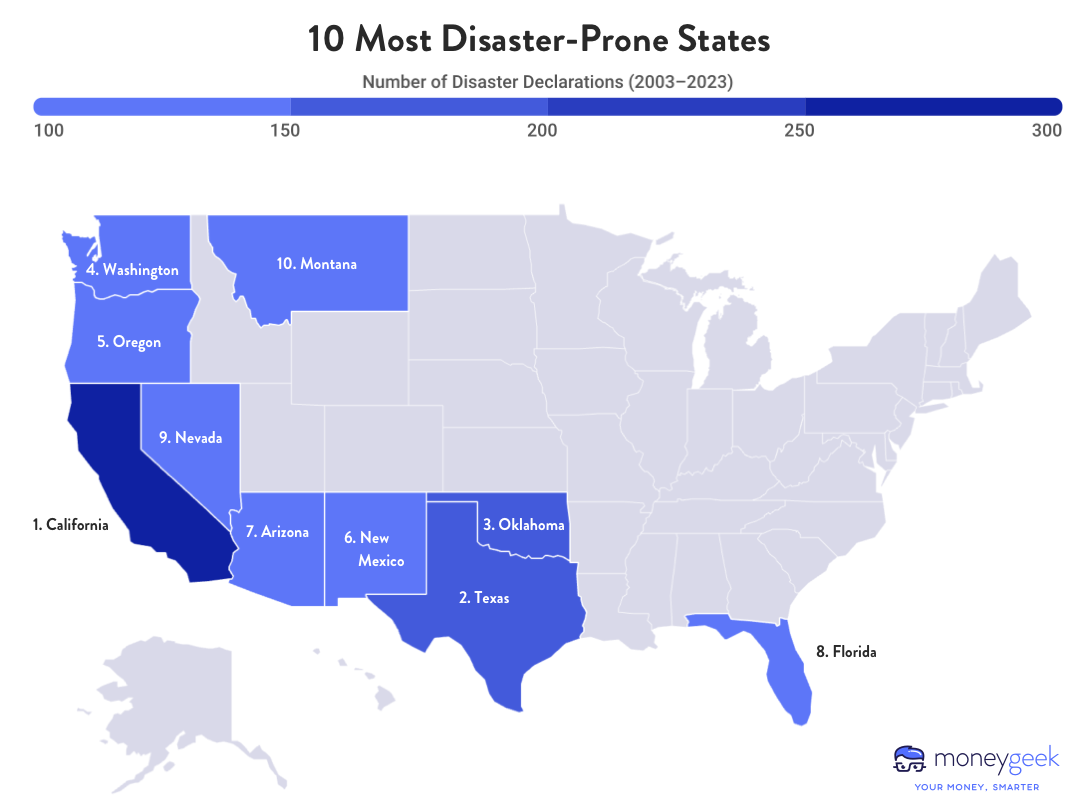
MoneyGeek
Key findings from our analysis
A color-coded US map showing the 10 most disaster prone states
California is the most disaster-prone state in the nation, with 282 disaster declarations since 2003. Although known for wildfires, the Golden State has endured eight severe storms in the past five years, the same number of storms that occurred over the preceding 14 years (from 2003 to 2017). For context, severe storms produce hail of one inch or larger, have winds exceeding 57.5 mph or spawn tornadoes.
Five states in the West are seeing a notable rise in the frequency of wildfires. Oregon, in particular, has seen the sharpest increase, with an average of six forest fires per year over the past five years — 85% higher than its 20-year average (3.25).
Florida and Louisiana have faced nearly $3 billion in homeowner property damage from severe storms and hurricanes in the past five years — almost six times more than the combined damage from the next two most impacted states, New York and New Jersey.
Although wildfires are the most common natural disaster, hurricanes inflict the most damage. Since 2003, these storms have racked up $21 billion in property damage in the U.S., even though they occur only one-fourth as frequently as wildfires.
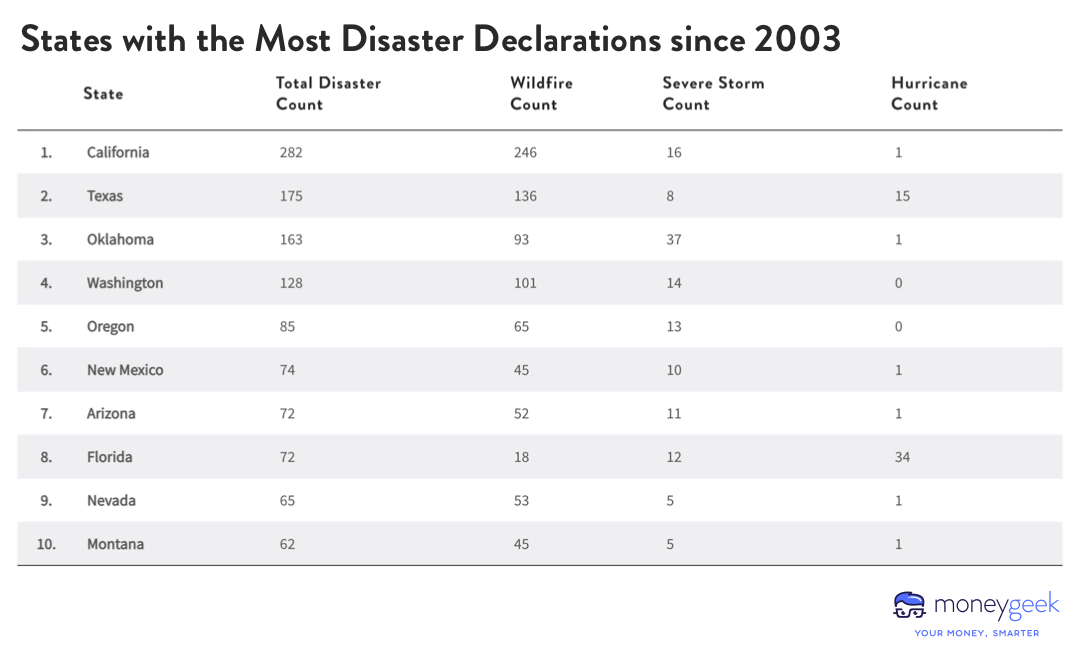
MoneyGeek
10 most disaster-prone states
A chart showing the US states with the most disaster declarations since 2003
From 2003 to July 2023, the U.S. tallied 2,602 disaster declarations across all 50 states. California led the way with 282 disaster declarations, primarily resulting from 243 wildfires — an average of 12 wildfires per year. California also weathered eight severe storms in just the last five years, equal to the number faced in the previous 15-year period from 2003–2017. To put it in perspective, intense storms produce tornados, winds over 57.5 mph, or hail of one inch minimum.
Outside California, other Western states — such as Washington, Oregon, New Mexico, Arizona, and Nevada — prominently feature in the top 10 disaster-prone regions, largely due to the increased frequency of fire-related incidents there.
Southern states — like Texas, Florida, and Oklahoma — also ranked in the top 10. Texas, with 136 wildfire declarations, ranked as the second most disaster-prone state in the country. Neighboring state Oklahoma — ranked No.3 overall— braved the most severe storms with 37 in total. Ranked as the No.8 most disaster-prone state, Florida faced 34 hurricanes — a number unmatched by any other state.
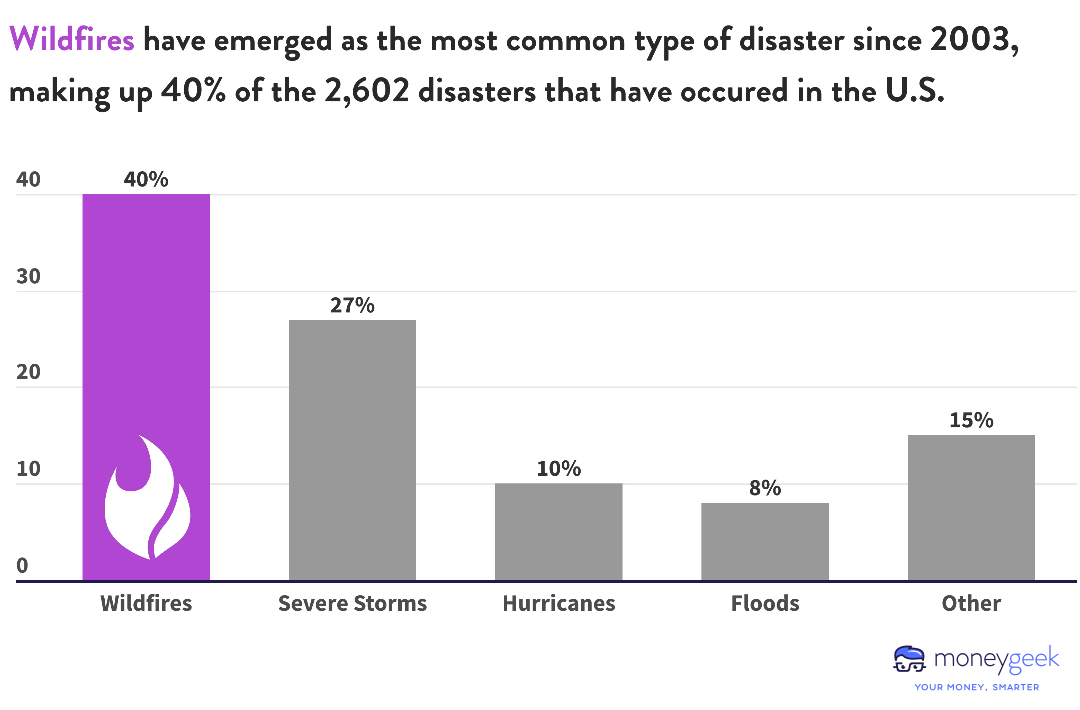
MoneyGeek
As the frequency and destructiveness of wildfires increases, the West is most affected
A bar chart showing a breakdown of the percentage of natural disasters that have occurred since 2003
With over 1,000 occurrences in the U.S. since 2003, wildfires have constituted 40% of the 2,602 total disasters in the country, marking them as the most frequent natural disaster. To understand the financial and economic impact of wildfires, we examined 20 years of data from the National Centers for Environmental Information (NCEI), focusing on disasters that racked up damages of $1 billion or more.
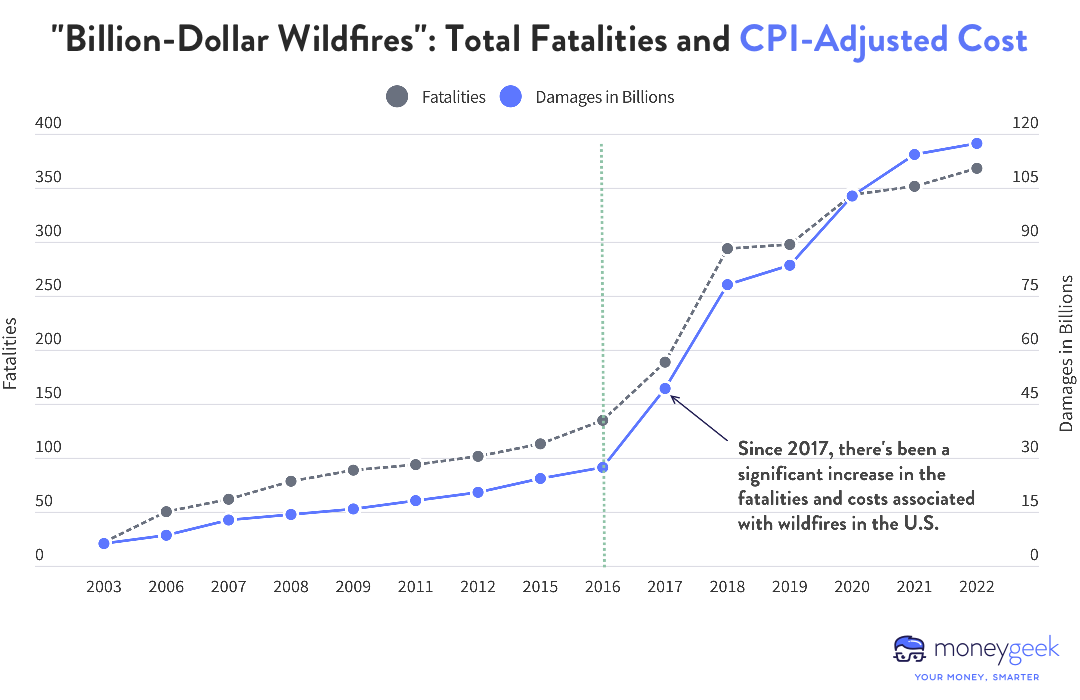
MoneyGeek
Since 2017, “billion-dollar” wildfires have become an annual occurrence
A line graph showing how the cost of annual wildfires has increased exponentially since 2017
MoneyGeek’s analysis uncovered 15 instances of “Billion-Dollar Wildfires” over this period, collectively responsible for $117 billion in damages and more than 300 lives lost. These wildfires have intensified in recent years, with a notable escalation in financial damages beginning in 2017. The annual growth rate of damages tied to wildfires increased from 11.9% between 2003 and 2016 to 18.9% between 2017 and 2022, translating to nearly a 60% increase.
Additionally, MoneyGeek compared the average number of wildfires that occurred annually between 2017 and 2023 with that of the last 20 years — specifically in states with more than 10 wildfires since 2003 — to understand how the frequency of wildfires has changed in the past five years. Notably, Western states, led by Oregon, are experiencing an alarming increase in wildfire frequency.
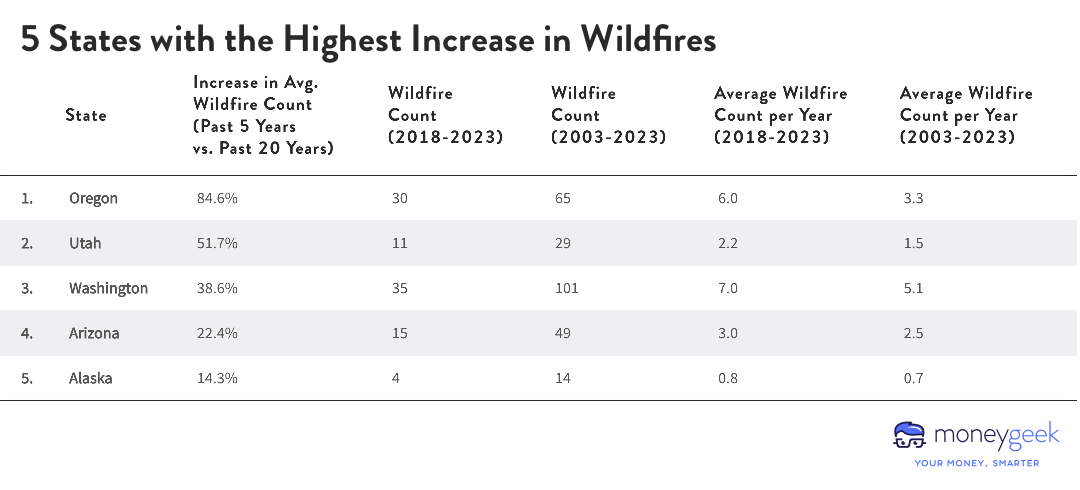
MoneyGeek
Each of the five states with the highest wildfire increase lies west of the Rockies
A table outlining the 5 states with the highest increases in wildfires
The five-year average for forest fires in Oregon reveals six incidents annually, representing an 85% surge compared to its 20-year average of 3.3.
Utah followed Oregon, with a five-year average rate that is 52% higher than its 20-year rate. Washington and Arizona are also among the top five, each recording an over 20% increase in the frequency of wildfires.
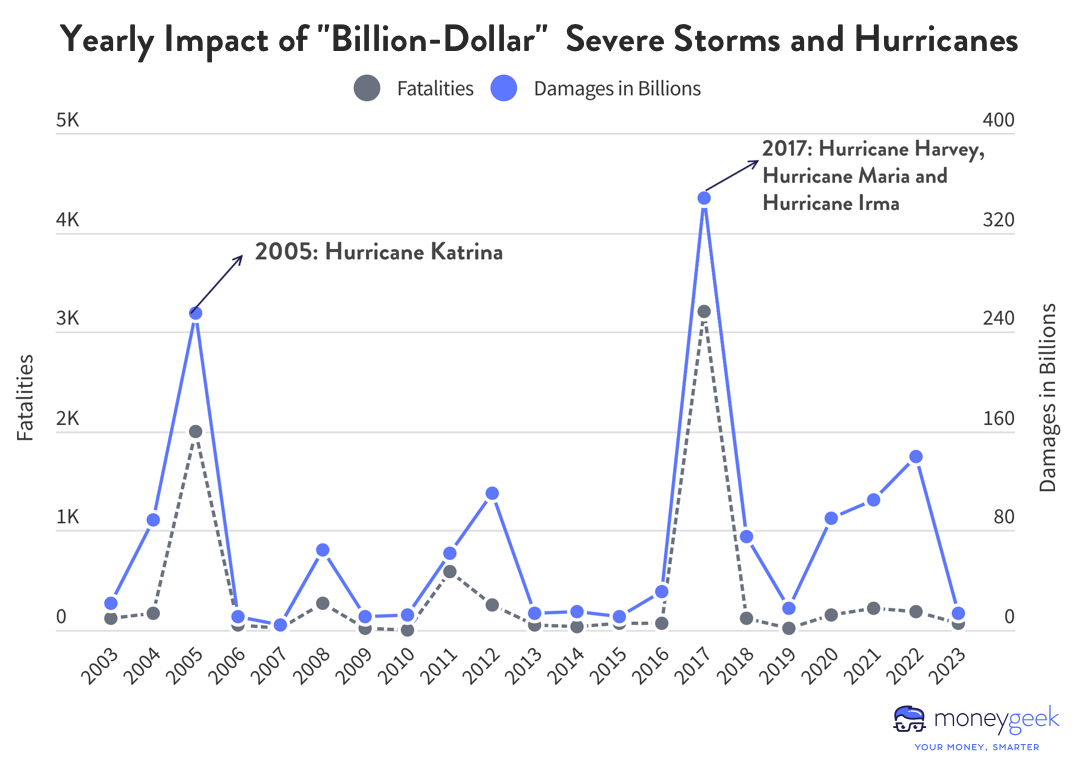
MoneyGeek
The financial impact of severe storms and hurricanes: Florida and Louisiana have it worst, and it’s not even close
A line graph showing the yearly impact of billion-dollar severe storms and hurricanes
Data from FEMA’s Housing Assistance Program shows that Florida and Louisiana have taken the biggest financial hits from severe storms and hurricanes, with a combined $3 billion in homeowner property damage from July 2018 to July 2023. This sum is nearly six times the combined damage toll of New York and New Jersey, the next two states most impacted by hurricanes and severe storms. Despite the comparatively smaller figures, these two states from the Northeast incurred considerable damage from severe storms and hurricanes, each state suffering over $200 million in damages since 2018.
5 states with the most homeowner property damage from storms and hurricanes
- Florida – $1,899,668,211
- Louisiana – $1,017,421,905
- New Jersey – $277,265,444
- New York – $210,255,251
- North Carolina – $195,739,160
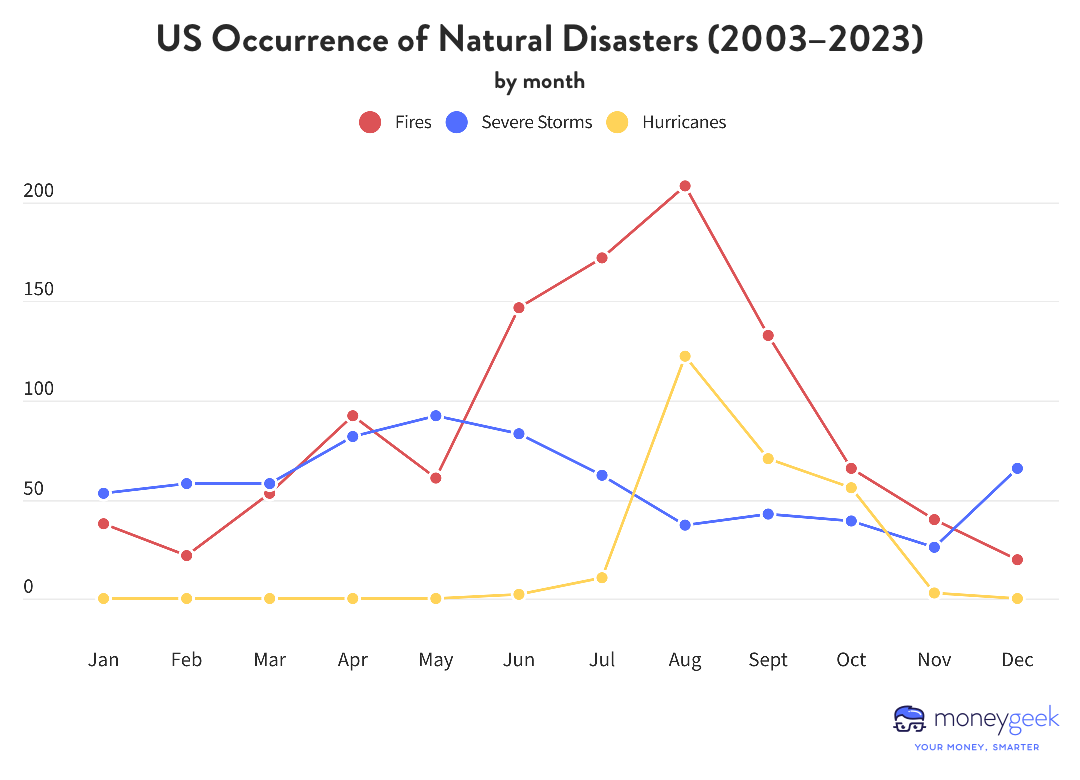
MoneyGeek
Bracing for nature’s fury: Predicting when disasters strike and protecting yourself
A line graph showing data on the occurrence of various natural disasters in the US from 2003-2023
Recognizing the cyclic nature of natural disasters is just one aspect of emergency preparedness. The inherent unpredictability of these events highlights the necessity of a dependable safeguard, represented by comprehensive insurance coverage. Homeowners should evaluate quotes from the best homeowners insurance companies and ensure they have robust protection. Likewise, renters need to compare options from the best renters insurance companies to secure their assets. If budget constraints are a concern, affordable homeowners insurance options and cost-effective renters insurance coverage are also available.
Methodology
To identify the most disaster-prone states in the U.S., MoneyGeek analyzed 20 years of disaster declaration data from the Federal Emergency Management Agency (FEMA). Data was accessed in July 2023. Our total disaster declaration count of 2,602 covers all types of incidents across all 50 U.S. states including natural events, man-made disruptions, and biological incidents, including COVID-19-related events from 2020. For the purposes of this analysis, we focused on wildfires, severe storms, and hurricanes.
To assess the economic consequences and loss of life related to wildfires, severe storms, and hurricanes, MoneyGeek conducted an examination of two decades’ worth of data from the National Centers for Environmental Information (NCEI). The focus of our examination was disasters that accrued damages amounting to at least $1 billion between January 2003 and July 2023.
To determine the states suffering the most financial impact from these disasters, we also examined homeowner property damage data from July 2018 to July 2023 from FEMA’s Housing Assistance Program, particularly its Individual Assistance program. This program offers financial support to households affected by disasters that are grappling with uninsured or under-insured necessary expenses and severe needs.
This story was produced by MoneyGeek and reviewed and distributed by Stacker Media.